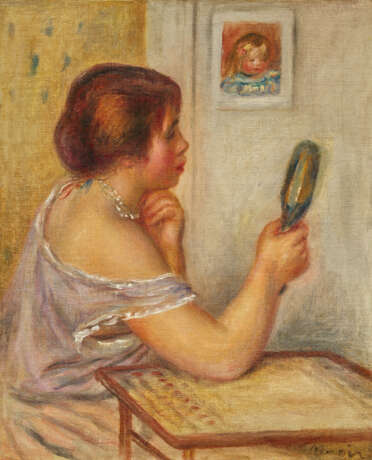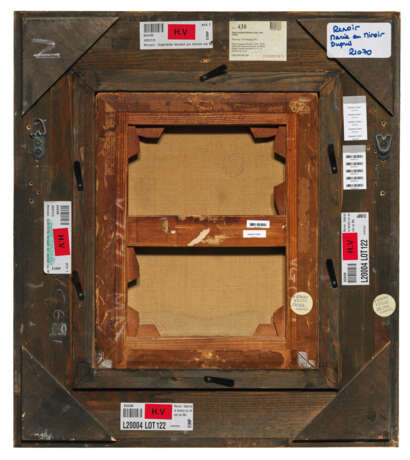ID 832316
Lot 160 | Pierre-Auguste Renoir (1841-1919)
Estimate value
€ 400 000 – 600 000
Marie Dupuis tenant un miroir avec un portrait de Coco ou Gabrielle devant son miroir
signé 'Renoir' (en bas à droite)
huile sur toile
38 x 31 cm.
Peint vers 1905
signed 'Renoir' (lower right)
oil on canvas
15 x 12 1/4 in.
Painted circa 1905
Provenance
Madame Schwob d'Héricourt, Paris (acquis auprès de l'artiste).
Alex Maguy, Paris (en 1962).
Monsieur et Madame François L. Schwarz, New York (avant 1973).
Madame Meta C. Schwarz, Paris et New York.
Vente, Sotheby's, Londres, 29 mars 1988, lot 9.
Collection particulière, Europe.
Pr. Hermann Schnabel, Hambourg.
Galerie du Carlton, Cannes.
Collection particulière, Allemagne (acquis auprès de celle-ci vers 2005); vente, Christie's, Londres, 10 février 2011, lot 438.
Vente, Sotheby's, Londres, 5 février 2020, lot 122.
Acquis au cours de cette vente par le propriétaire actuel.
Literature
F. Daulte et J. Focarino, Privately Owned, Paintings and Drawings from the Collection of François L. Schwarz, New York, 1973, p. 56 (illustré en couleurs, p. 57).
G.-P. et M. Dauberville, Renoir, Catalogue raisonné des tableaux, pastels, dessins et aquarelles, 1903-1910, Paris, 2012, vol. IV, p. 341-342, no. 3258 (illustré, p. 341).
Exhibited
Tokyo, Isetan Museum of Art et Kyoto, Municipal Museum, Exposition Renoir, septembre-décembre 1979, no. 69 (illustré en couleurs).
Tubingue, Kunsthalle, Renoir, janvier-mai 1996, p. 285, no. 94 (illustré en couleurs, p. 284).
Post Lot Text
Durant les années 1890, Renoir apprivoise dans ses portraits un style très intimiste, parfaitement en accord avec la représentation de ses proches, de ses amis ou de ses voisins, désormais nombreux à vouloir prendre la pose dans son atelier. Le modèle du présent tableau a longtemps été pris pour Gabrielle Renard, venue s'installer en tant que nourrice chez les Renoir à l'âge de seize ans, en 1894, un mois avant la naissance de Jean. Elle ne quittera le cercle familial qu'une vingtaine d'années plus tard, après son mariage avec le peintre américain Conrad Slade en 1912. Membre indispensable de la maisonnée durant ces longues années, Gabrielle prend non seulement soin des enfants et de l'artiste gagné, peu à peu, par la maladie, mais pose aussi très fréquemment pour Renoir, incarnant tour à tour des personnages de ses scènes domestiques et les nus voluptueux qui occuperont tant l'esprit de l'artiste à partir de 1900. De plus récentes appréciations du présent portrait laissent toutefois entendre qu'il s'agirait en réalité de Marie Dupuis, autre modèle privilégié du peintre qui coiffait ses cheveux en arrière de cette façon. Dupuis, que l'artiste surnommait affectueusement « la Boulangère », venait d'Essoyes, la ville natale de son épouse, et avait été engagée comme employée de maison chez les Renoir en 1899.
Renoir saisit ici son modèle dans un moment très intime, tandis qu'elle ajuste son collier devant le miroir, un portrait de « Coco » accroché au mur auprès d'elle. « Coco » était le surnom du troisième fils de Renoir, Claude, né en 1901. Ce tableau qui apparaît à l'arrière-plan a probablement été peint un ou deux ans avant la présente œuvre et ressemble fort à une toile actuellement conservée au Museu de arte de São Paulo Assis Chateaubriand, au Brésil. Comme le souligne Jean Renoir, Coco a sans doute été « l'une des sources d'inspiration les plus prolifiques que [son] père ait connues » (J. Renoir, Pierre-Auguste Renoir, mon père, Paris, 1981) ; la multitude de portraits que l'artiste lui a consacrés constituent d'ailleurs un catalogue très complet des huit premières années de sa vie.
Lorsqu'il peint la figure féminine, Renoir cherche à révéler la part enfantine qui réside encore au plus profond de l'être – le velouté lumineux de la peau, la délicatesse de la chair, et le tempérament de la petite fille enfouie à l'intérieur de la femme. George Rivière écrit que « Dans le tableau de figure de Renoir, l’art du portrait occupe une place spéciale en elle-même. Aucun autre artiste n’a regardé si profondément dans l’âme de son modèle, ni capturé son essence avec une telle économie » (cité in C. Bailey, Renoir's Portraits, Impression of an Age, Ottawa, 1997, p. 1). Renoir aborde ses sujets féminins avec sensibilité et empathie sans se plier pour autant aux contraintes laborieuses du portrait. « Sans le moindre jugement, il saisit toute la présence de son modèle. De son point de vue, le visage se résume aux yeux et à la bouche – le reste n'est que caresse. Les yeux et la bouche condensent toute la féminité et la beauté de la femme, mais sont aussi la porte qui mène vers l'âme de l'être humain, et jusque dans sa chair » (M. Florisone, Renoir, Londres, 1942, p. 26).
In the 1890s Renoir had developed a very intimate style of portraiture that was well suited to portraying the family members, friends and neighbours he asked to pose for him. The sitter for the present work was originally thought to be Gabrielle Renard, who at the age of 16 joined the Renoirs' household in 1894, a month before Jean was born. Gabrielle remained with the family for the next twenty years, until her marriage to the American painter Conrad Slade in 1912. She soon became indispensable to the Renoirs, not only looking after the children and, later, the increasingly infirm artist, but also modelling frequently for Renoir, both as the protagonist of his domestic scenes and as the voluptuous nude which so preoccupied the artist post-1900. However more recently, it has been suggested that the sitter is Marie Dupuis, another of Renoir's favoured models, as she typically wore her hair pulled back in this style. Affectionately called la boulangère by the artist, Marie Dupuis hailed from his wife's home town of Essoyes and joined the household as a servant in 1899.
The sitter is portrayed in a very private moment, adjusting her necklace in the mirror with a portrait of 'Coco' on the wall behind her. 'Coco' was Renoir's third son, Claude, who was born in 1901. The painting depicted in the background was probably painted a year or two earlier than the present work and is remarkably similar to the portrait now in the Museu de Arte de São Paolo, Assis Chateaubriand São Paolo, Brazil. As Jean Renoir later recalled, Coco was 'one of the most prolific inspirations my father ever had' (J. Renoir, Pierre-Auguste Renoir, mon père, Paris, 1981) and Renoir's paintings of him provide a complete catalogue of the first eight years of his life.
When painting a female figure, Renoir sought to reveal that which still remained in her from the child within - the luminous softness of the skin, her delicate flesh, and the character of her inner youth. As George Rivière was to comment, 'In Renoir's figure painting, portraiture deserves a place unto itself. For no other artist has looked so deeply into his sitter's soul, nor captured its essence with such economy' (quoted in C. Bailey, Renoir's Portraits, Impression of an Age, Ottawa, 1997, p. 1). In his female portraits, Renoir paints with sympathy and sensibility but never submits to the negative constraints of portraiture: 'Without judgement, he captures the presence of his model. As he viewed it, the face was the eyes and the mouth - the rest was but a caress. The eyes and the mouth enclose the beauty and femininity of a woman, while being the portals of the human being leading towards the soul and into the flesh' (M. Florisone, Renoir, London, 1942, p. 26).
| Artist: | Pierre-Auguste Renoir (1841 - 1919) |
|---|---|
| Applied technique: | Oil on canvas |
| Auction house category: | Paintings |
| Artist: | Pierre-Auguste Renoir (1841 - 1919) |
|---|---|
| Applied technique: | Oil on canvas |
| Auction house category: | Paintings |
| Address of auction |
CHRISTIE'S 9 Avenue Matignon 75008 Paris France | ||||||||||||||
|---|---|---|---|---|---|---|---|---|---|---|---|---|---|---|---|
| Preview |
| ||||||||||||||
| Phone | +33 (0)1 40 76 85 85 | ||||||||||||||
| Fax | +33 (0)1 40 76 85 86 | ||||||||||||||
| Conditions of purchase | Conditions of purchase | ||||||||||||||
| Shipping |
Postal service Courier service pickup by yourself | ||||||||||||||
| Payment methods |
Wire Transfer | ||||||||||||||
| Business hours | Business hours
|
















